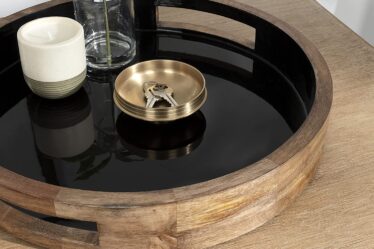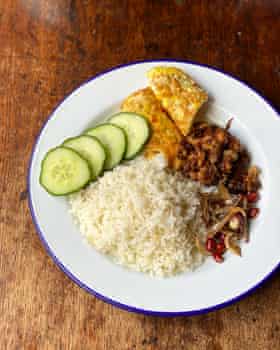
Described by the Malay Mail as the country’s “undisputed national dish”, nasi lemak (which literally translates as “rich rice”) is so beloved in its homeland that one in two people questioned in a recent survey chose it as their all-time favourite breakfast, and it has inspired spin-offs from ice-cream to McDonald’s burgers.
Like many such comfort foods, its charm lies in its versatility; at its simplest, nasi lemak is just a pile of fluffy, aromatic rice with a spicy sambal and crunchy garnish, all served in a banana leaf, though these days it’s often accompanied by more substantial dishes, such as rendang or fried chicken, and eaten at lunch and dinner, too.
Many online column inches have been devoted to finding the best nasi lemak in Kuala Lumpur or Penang, but if you’re not fortunate enough to have a Malaysian restaurant or a hawker centre around the corner, have a go at this recipe to see why it is, in the words of Kuantan-born fan and MasterChef contestant Zaleha Kadir Olpin, Malaysia’s “most iconic dish”.
The rice
This is the backbone of nasi lemak, and the recipes I try are divided between recommending basmati or jasmine for the purpose, both of them being long grains prized for their aromatic qualities. Sharon Wee, author of Growing Up in a Nonya Kitchen, prefers not to use jasmine, because “the fragrance of the rice somewhat undermines the full essence that stems from the pandan leaves and the coconut milk” that go into it. Instead, she calls for simple long-grain, which has the bonus of being cheaper, too. However, if you do have basmati or jasmine to hand already, either will work fine; I slightly prefer the fluffier texture of the former.
Rather than just water, the rice is usually cooked in a mixture of coconut milk and water or, in Kadir Olpin’s case, just coconut milk; Wee explains that the more coconut you use, the more “lemak” the finished dish, so though I’ve suggested the same half-and-half ratio as her, with a spoonful of coconut cream stirred in at the end, if desired, feel free to adjust this to your taste.
Wee and Kadir Olpin recommend using a rice cooker – a very common kitchen appliance in Malaysia, but less so in cultures where rice isn’t the staple carb – though they also give instructions for the absorption method, which leaves the grains pleasingly fluffy, particularly once the cooked rice has been steamed in a basket for an additional 10 minutes, as Wee suggests, to give it an especially rich flavour and texture.
Norman Musa, chef, restaurateur and author of Amazing Malaysian, boils soaked rice for eight minutes, then leaves it to cook in its own steam for 15, while Ping Coombes – who, like Kadir Olpin, served her beloved nasi lemak to the MasterChef judges – brings it to a simmer and then leaves it covered for half an hour. Much as I like Wee’s rice, in particular, Musa’s method is easiest for the home cook, because there’s only one pan to wash up at the end, so I’m going with that. If you’re lucky enough to have a rice cooker, however, do of course use that instead.
![Bee Yinn Low’s nasi lemak: ‘Pandan leaves [are] the secret ingredient.’](https://fashnfly.com/wp-content/uploads/2022/04/1649244186_941_How-to-make-the-perfect-nasi-lemak-–-recipe.jpg)
Bee Yinn Low, author of the popular Rasa Malaysia blog, tells readers that “pandan leaves or screwpine leaves [are] the secret ingredient” here: “highly fragrant with floral smell … a nasi lemak will not be authentic without the leaves.” Fresh and slightly soapy, pandan is one of my favourite aromatics, but sadly it’s not something commonly sold in British supermarkets. I found it in the freezer of a South-East Asian grocer, but if you have no luck, try looking for kewra water in Indian specialists and add a dash of that at the end instead.
Musa and Kadir Olpin add cinnamon and, like Coombes, fresh ginger, and Musa also pops in some star anise and lemongrass. The more spices you add, the more perfumed your rice will be; I love pandan so much, however, that I’m going to leave it at that, but feel free to be bolder, if you like.
The sambal
The other must-have here is a sambal, which Low describes as “the soul of the dish; it brings together all the various toppings and complete the iconic dish”. Kadir Olpin explains in her book, My Rendang isn’t Crispy (a nod to her experience on MasterChef), that “in South-East Asia, sambal is the standard name for any spicy dish where blended chillies are the main ingredient”. Her version, she says, is a basic vegetarian one, missing the belacan (fermented shrimp paste) or dried anchovies found in other recipes, but otherwise fairly similar – a spice paste of chillies, shallots, onion, garlic and lemongrass, all fried in plenty of oil and flavoured with brown sugar and tangy tamarind to give a deep, mellow, sweet-and-sour accompaniment with a satisfying, but not overpowering warmth.

Musa notes that such a sambal traditionally takes “hours to make. The longer you simmer, the milder it becomes. The heat will fade away, and all you can taste is the aftertaste.” Mindful of the constraints faced by the average home cook, he gives a version that takes just seven minutes – rather than the 90 for which I hang anxiously over Kadir Olpin’s – and it yields a delicious, but markedly less complex compromise. The other recipes fall somewhere in between, but all are very clear that one should fry the sambal until the oil separates out, which is something that cannot be rushed.
The chillies, of course, are the most important element of any sambal: everyone uses dried, usually soaked or boiled first (I find boiling a more efficient way to soften them before blitzing them to a paste), and Kadir Olpin and Coombes both use fresh chillies, too, which, though not essential, do bring a fruitier flavour, as well as some extra colour. Alliums are also vital; shallots are more common, though you can use a red or even yellow onion, at a pinch (shallots are sweeter and milder than onions, so I’d recommend going with red, if needs must). Garlic is also common, but not mandatory. Aromatics such as ginger and lemongrass fall into the same category, though the warmth of the ginger pairs so well with the peppers that I can’t leave it out.

The sweetness generally comes from sugar, often brown, sometimes coconut, and the tanginess from tamarind. Some recipes call for making your own tamarind water by soaking the pulp and squeezing it out, while others go for tamarind paste. Though the latter cuts down on work for the cook, my one piece of advice is to taste yours before use; it can be almost as brown and thin as the homemade stuff, or as thick and black as treacle, so start off small and adjust to taste.
The savoury element generally comes from the aforementioned belacan, which is sold in blocks for grating – you could substitute fish sauce or a vegan equivalent, if you like, but the blocks keep for ages, so are well worth the investment. (Vegetarians might be interested to know that Coombes also adds a dash of soy sauce to hers.) Low, Coombes and Wee add tiny dried anchovies to their sambals, which gives them more body, as well as flavour, but I’d prefer to serve them separately.
Note that the sambal can be made several days in advance to cut down on prep time – it keeps very well in the fridge. (You may also be interested to know that you can buy excellent sambal in jars: Lucullus and Makan Malaysia are the most widely recommended brands in a quick online poll.)
The extras
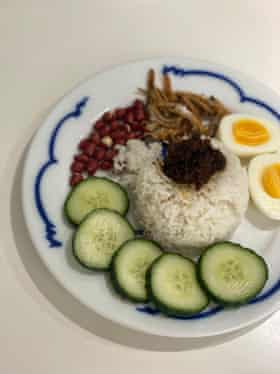
The other traditional accompaniments to nasi lemak are all sorts of nice, crunchy things such as peanuts, cucumber and, most worthwhile of all in my opinion, the tiny dried anchovies sold by the bagful. Unprepossessing as they might appear, once fried to a crisp, they’re as moreish as bacon, and distinctly Malaysian. A peeled and halved boiled egg typically rounds off the dish, though fried eggs are increasingly popular.
If you’d like to turn this from breakfast to feast, Coombes includes recipes for turmeric fried chicken coated in salted crisps, and a mild, creamy tiger prawn sambal, while Wee goes for a mild, fruity shrimp sambal, otak-otak (a spicy, grilled fish paste) and a chilli and shallot omelette; Low opts for squid sambal, Kadir Olpin suggests one of her rendangs, while Musa’s mother used to sell nasi lemak with anchovy sambal and long beans in a curry sauce. If it’s your first time, however, I’d recommend sticking with the below. It’s hard to beat.
Perfect nasi lemak
Prep 35 min
Soak 20 min
Cook 1 hr 45 min
Serves 4 (and easily multiplied or divided)
For the sambal
20 largish dried red chillies
5 fresh red chillies
7 small round shallots
2 plump garlic cloves
30g piece fresh ginger
75ml neutral oil, such as vegetable or sunflower
2 tsp belacan (fermented shrimp paste)
Tamarind paste or tamarind water, to taste (see introduction) – I used 1 tbsp
Sugar, to taste – I used 1 tbsp
Salt, to taste
For the rice
375g long-grain rice
1 x 400ml tin coconut milk
1 tsp salt
2 pandan leaves
2 tbsp coconut cream (optional, or use the cream on top of the milk)
For the accompaniments
50g peanuts
50ml oil
50g dried anchovies
4 eggs
½ cucumber
Start with the sambal. Remove and discard the stalks from the dried chillies, then roughly break them up and put in a small pan of boiling water.
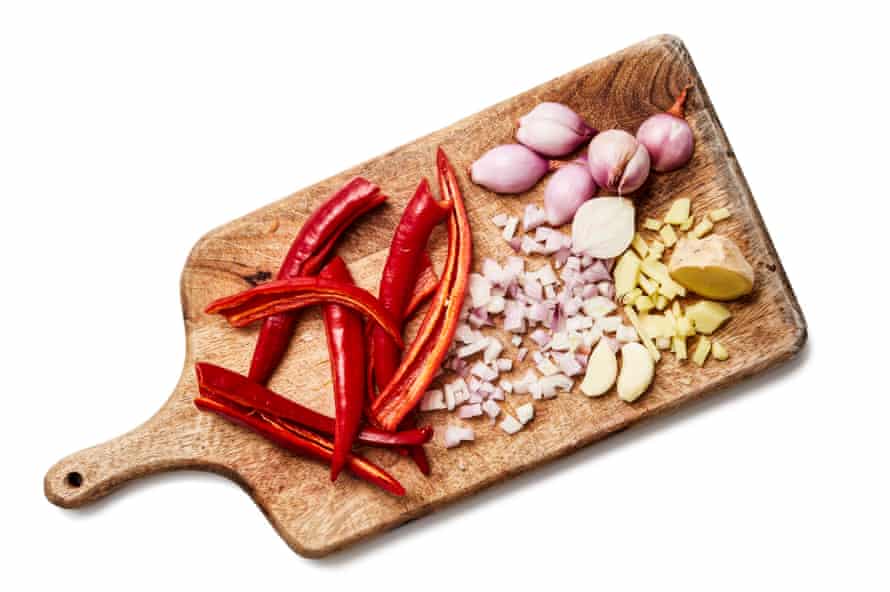
Simmer for 15 minutes, then drain, reserving a little of the cooking water (a teaspoon or so). Meanwhile, trim and deseed the fresh chillies and peel and roughly chop the shallots, garlic and ginger.
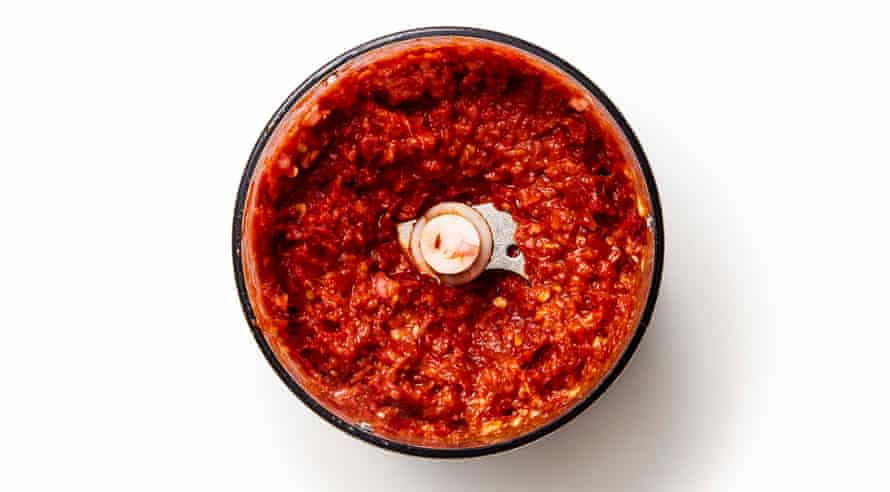
Whizz or pound the soaked dried chillies with their reserved soaking liquid to make a paste, then add the fresh chillies, shallots, garlic and ginger, break down into a puree, then crumble in the belacan.
Heat the oil in a wok or small pan over a medium heat, add the paste and fry, stirring often so it doesn’t burn, until the oil separates out; add a little water if it begins to stick.
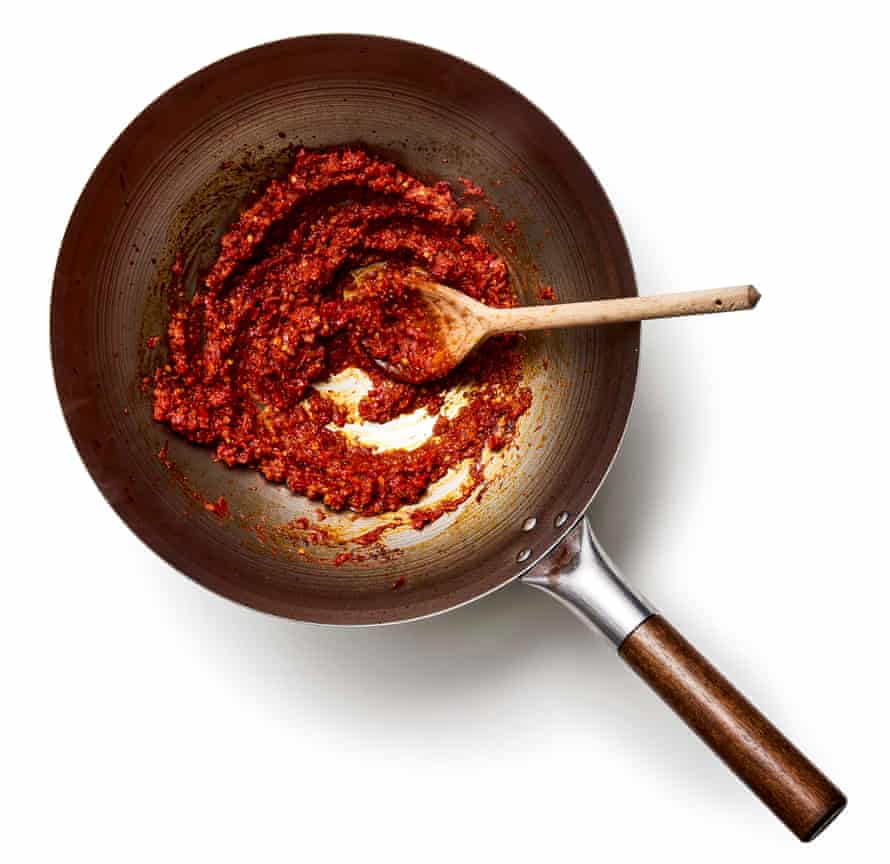
Stir in a teaspoon of tamarind, a teaspoon of sugar and a good pinch of salt, adjust to taste, then turn down the heat and fry, still stirring regularly, until the oil separates again.
Rinse the rice, then soak it in cold water for 20 minutes. Drain and put in a medium saucepan with the coconut milk – if there’s a big lump of cream on top, save this for later. Add salt and enough water to come up to the first joint of a finger poked in to the top of the rice. Tie the pandan leaves in a knot, so they fit the pot better, then nestle into the rice.
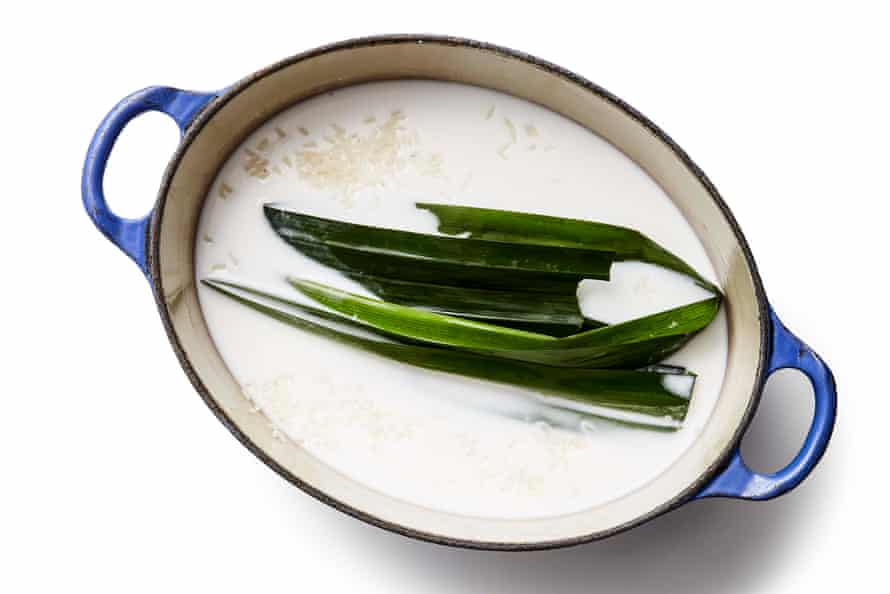
Stir well, bring to a simmer, then cover, turn down the heat slightly and leave to cook for 10 minutes. Quickly add the coconut cream, put a clean tea towel on top, cover again and leave for 15 minutes.
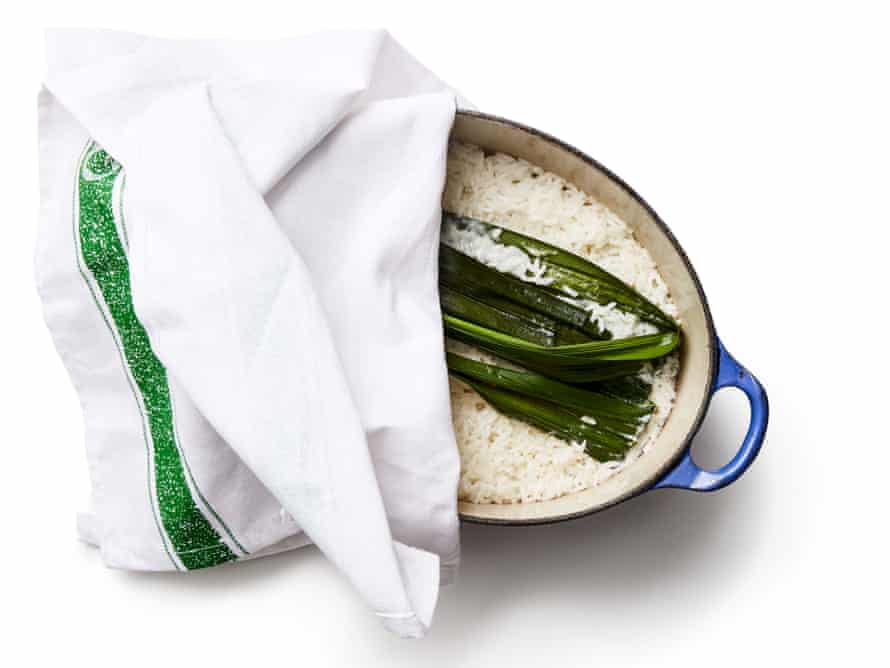
Fry the peanuts in a dry pan until you can smell them toasting, then set aside. Heat the oil in the same pan, fry the anchovies until crisp and golden, then tip them on to a piece of kitchen paper to drain.
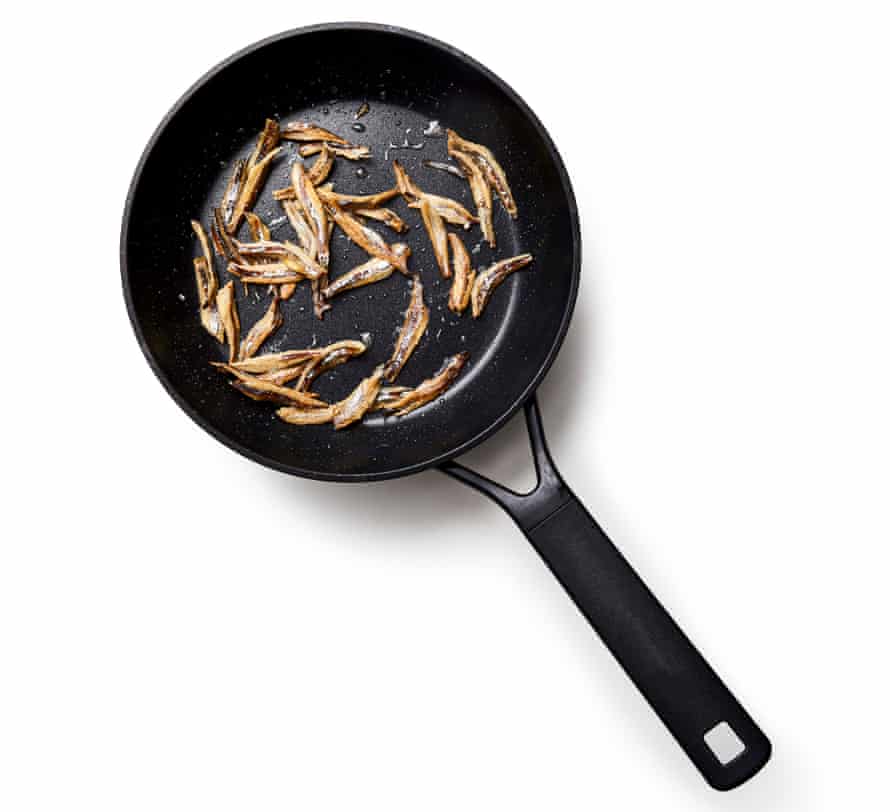
Boil the eggs for seven to nine minutes, depending on how hard-boiled you like them, then cool under running water, peel and halve. Cut the cucumber into thick slices.
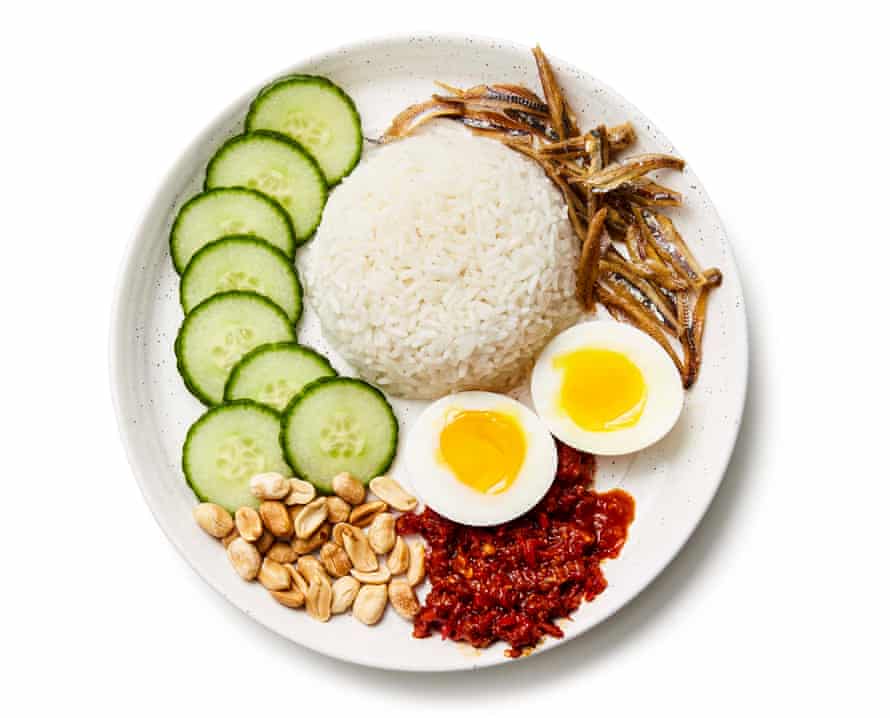
To serve, put a mound of rice on each plate, add a spoonful of sambal to the side, then add the peanuts, anchovies, eggs and cucumber alongside. Serve the rest of the sambal on the table for people to help themselves.
-
Is the humble nasi lemak worthy of the title of national icon, and why does it have such a special place in the heart of so many Malaysians? Where and how do you like to eat yours, and which other regional versions would you recommend?


